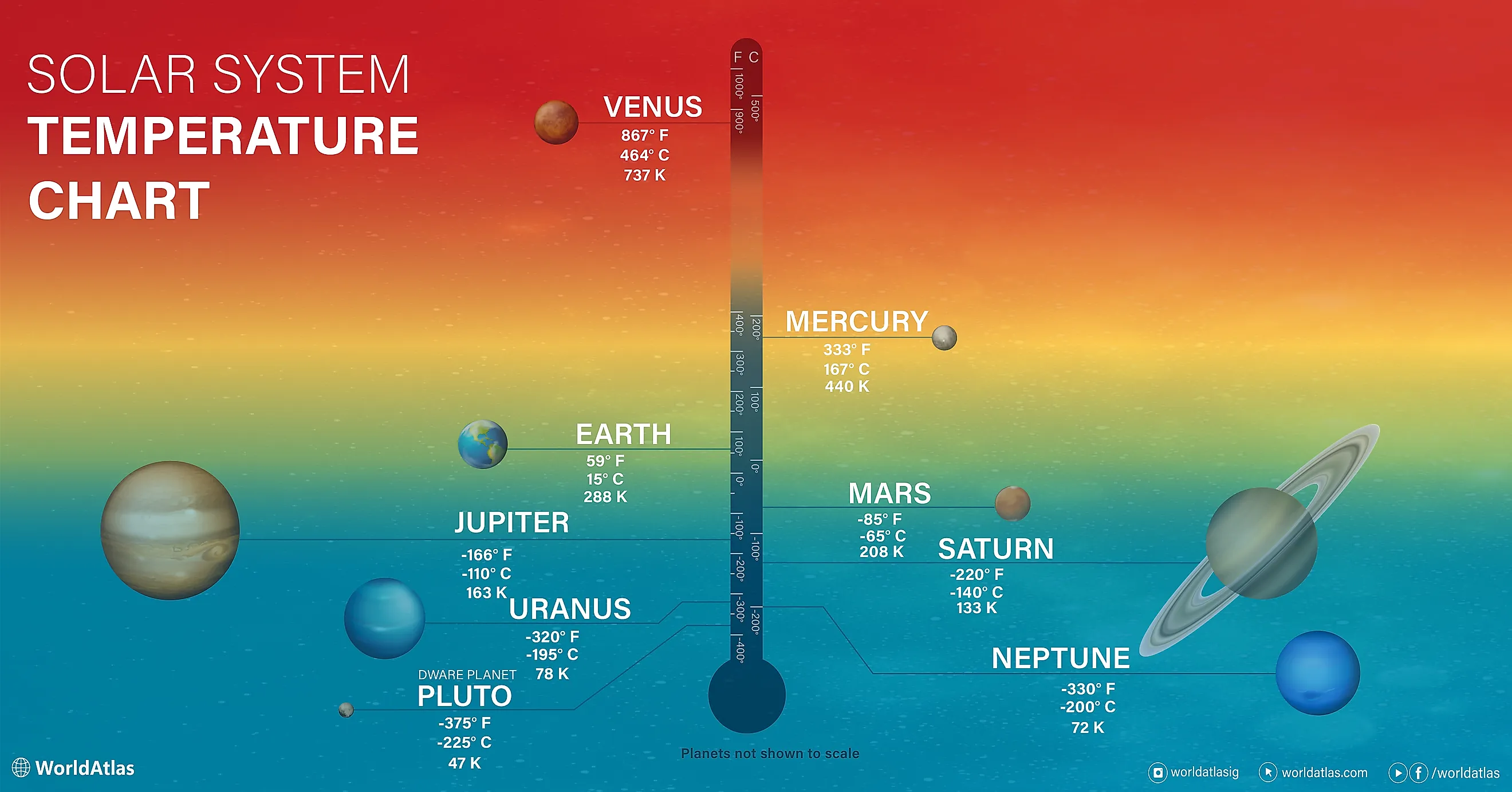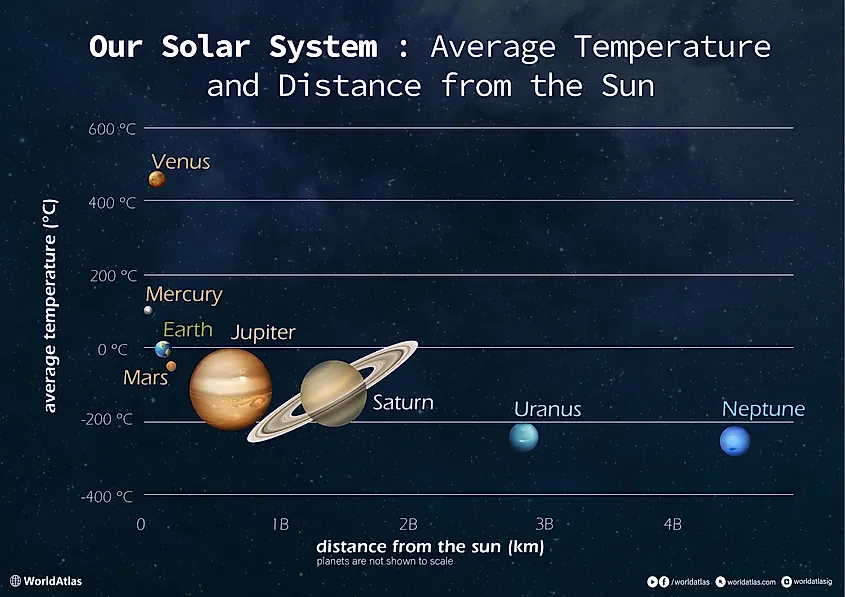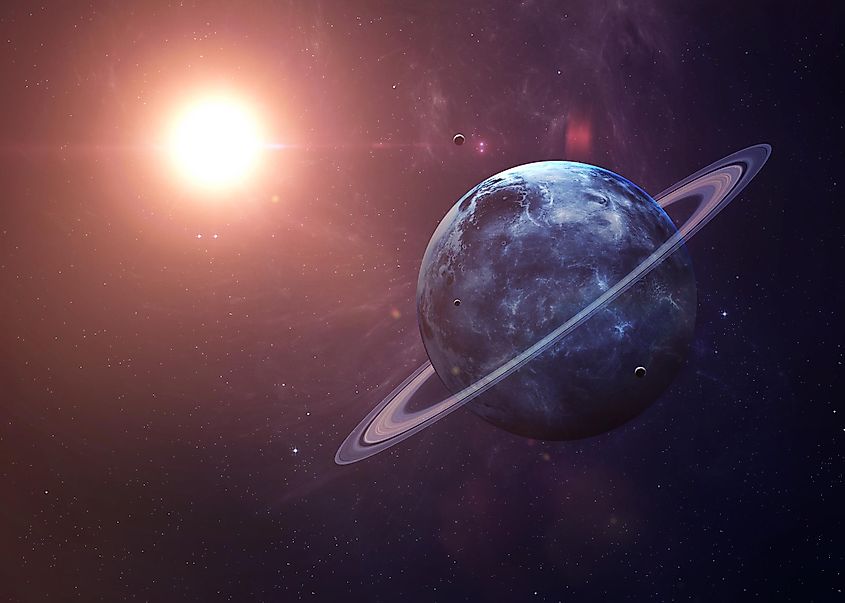
The Hottest And Coldest Planets Of Our Solar System
In our Solar System, planets are traditionally categorized according to their composition into terrestrial bodies, composed primarily of rocky material, and giant planets, which include both gas and ice giants. Their respective temperatures are largely determined by each planet’s internal structure and its orbital distance from the Sun. In addition, variations in atmospheric composition and properties play a critical role in regulating how much heat is emitted and retained, thereby influencing the overall thermal profile of these celestial bodies.
Of all the planets in our solar system, Venus and Mercury are the hottest, with average temperatures of 464 °C and 167 °C, respectively, while Neptune and Uranus are the coldest, with average temperatures of -200 °C and -195 °C, respectively. Let's explore the factors that lead to such substantial variations.
The Inner Planets

As one might expect, the planets closest to the Sun are the warmest. The four inner planets, Mercury, Venus, Earth, and Mars, are warmer than the outer gas giants. However, the temperature of the planets does not follow a linear path from the Sun.
Mercury
Despite being the closest planet to the Sun at a distance of 36 million miles (58 million kilometers), Mercury is not the hottest planet in the solar system. Mercury may be the closest planet to the Sun, but it does not have a significant atmosphere. Without an atmosphere, Mercury cannot regulate its surface temperature, so temperatures can change drastically depending on the amount of sunlight. During the day, Mercury experiences temperatures of 800 degrees Fahrenheit (430 degrees Celsius). However, without an atmosphere to distribute temperature around the planet, nighttime temperatures drop as low as minus 290 degrees Fahrenheit (minus 180 degrees Celsius).
Venus
Venus is the second closest planet to the Sun, and it’s the hottest planet in the solar system. Venus orbits the Sun at a distance of 67 million miles (108 million kilometers). That is nearly twice as far as Mercury. In fact, Venus is closer to Earth than it is to Mercury. Despite being relatively far from the Sun, Venus experiences an average surface temperature of 864 degrees Fahrenheit (462 degrees Celsius). That’s hot enough to melt lead!
But still, Venus is hotter than Mercury, which is due to the former's distinctive atmospheric composition. The atmosphere of Venus is 96% carbon dioxide. Carbon dioxide is a greenhouse gas that traps sunlight and keeps it near the surface. This phenomenon is known as the greenhouse effect. A moderate greenhouse effect can be a good thing for a planet in that it helps maintain temperatures and stops a planet from freezing over. However, Venus has a runaway greenhouse effect. The amount of carbon dioxide in Venus’ atmosphere traps all the sunlight that manages to penetrate the cloud layers of Venus. The Sun’s heat cannot escape, and it builds on the surface, causing temperatures to skyrocket. Interestingly, the number of clouds on Venus would otherwise make it a colder planet than Earth. Venus reflects roughly 70% of the sunlight that hits it and absorbs the other 30%. If it were not for its runaway greenhouse effect, Venus would be colder than Mercury and Earth.
Earth
The Earth has the most stable and livable temperatures in the solar system. Earth is fortunate to find itself in what’s called the habitable zone. Every star is surrounded by a thin band of habitability called the habitable zone. The habitable zone is defined as the region around a star where, given the right conditions, water can exist in liquid form on the surface. Orbiting the Sun at a distance of 93 million miles (150 million kilometers), the Earth finds itself orbiting the Sun in the middle of its habitable zone. Combine an orbit in the habitable zone with a stable atmosphere and a moderate greenhouse effect, and you end up with a planet with a steady, consistent temperature. The average surface temperature on Earth is 57 degrees Fahrenheit (14 degrees Celsius), which happens to be perfect for the existence and flourishment of life.
Mars
Mars is the coldest of the inner rocky planets, and it orbits just outside the Sun’s habitable zone at an average distance of 142 million miles (228 million kilometers). At such a vast distance, it’s no surprise that Mars is colder than the Earth. Surface temperatures on Mars average at minus 80 degrees Fahrenheit (minus 60 degrees Celsius). Not only is Mars far away from the Sun, but its atmosphere is also very thin when compared to the Earth’s. Although Mars’ atmosphere is mostly carbon dioxide, the atmosphere isn’t thick enough for a significant greenhouse effect to exist. Without a dense atmosphere, temperatures can fluctuate wildly across the surface. The coldest temperature ever recorded on Mars was minus 200 degrees Fahrenheit (minus 122 degrees Celsius), while the warmest temperature ever recorded was a moderate 70 degrees Fahrenheit (21 degrees Celsius).
The Outer Planets

The outer solar system is far colder than the inner solar system. The four planets that orbit the Sun in this region are far colder than the four inner worlds.
The Gas Giants
Jupiter is the closest gas giant to the Sun and is thus the warmest planet in the outer solar system. The upper atmosphere of Jupiter averages at minus 234 degrees Fahrenheit (minus 145 degrees Celsius). Unlike the inner rocky planets, the temperature of the gas giants does not vary depending on your location from the equator. Since a planet's equator will generally experience the most sunlight, temperatures will reach their highest. The farther you move away from the equator, the colder the temperature. Since Jupiter and the other gas giants are so far away from the Sun, their temperatures are determined not by sunlight but by internal heat. Jupiter generates a tremendous amount of heat from its core, and although temperatures are very cold in the upper atmosphere, it is an entirely different story deep within the planet. A mere 600 miles (1,000 kilometers) from Jupiter’s core, temperatures reach as high as 1,340 degrees Fahrenheit (725 degrees Celsius). What is true for Jupiter is true for Saturn, Uranus, and Neptune. Rather than the Sun providing heat, all of the gas giants produce their internal heat.
The Ice Giants
Neptune is the farthest planet from the Sun, yet it is not the coldest planet in the solar system. That honor goes to Uranus. Despite being closer to the Sun than Neptune, Uranus is slightly colder. Uranus has an average surface temperature of minus 374 degrees Fahrenheit (minus 224 degrees Celsius). Meanwhile, Neptune experiences an average surface temperature of minus 353 degrees Fahrenheit (minus 214 degrees Celsius). The difference in temperature between Neptune and Uranus may not seem like much, but when we consider that Uranus is about a billion miles closer to the Sun than Neptune, it does seem a bit strange. As of yet, the temperature difference between these two worlds is still a mystery, yet Neptune’s warmer temperature is likely due to some internal process that keeps it warmer than Uranus.
Solar System Planets Ranked From Hottest To Coldest
| Rank | Planet | Average Temperature |
|---|---|---|
|
1 |
Venus |
864 °F (462 °C) |
|
2 |
Mercury |
800 °F 430 °C) |
|
3 |
Earth |
57 °F (14 °C) |
|
4 |
Mars |
-80 °F (-60 °C) |
|
5 |
Jupiter |
-234 °F (-145 °C) |
|
6 |
Saturn |
-218 °F (-138 °C) |
|
7 |
Neptune |
-353 °F (-214 °C) |
|
8 |
Uranus |
-374 °F (-224 °C) |











